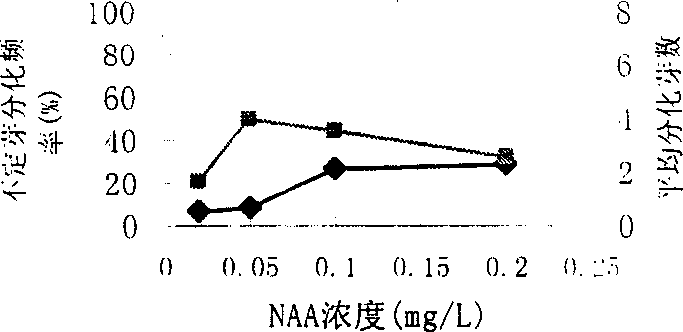Gene transfer method of agrobacterium of poplar
A technology of gene transformation and Agrobacterium, applied in the field of genetic engineering, can solve the problems of leaf-eating pests and the establishment of a transgenic system for poplar in Xinjiang, etc.
- Summary
- Abstract
- Description
- Claims
- Application Information
AI Technical Summary
Problems solved by technology
Method used
Image
Examples
Embodiment 1
[0026] Xinjiang poplar test-tube seedlings are subcultured by root sprouting and tillering. The basic medium is 1 / 2MS, sucrose 25-30g / L, pH5.6-5.8, agar 6-7g / L, 121+1℃, sterilized for 16 -20min. All the additional auxins, cytokinins and antibiotics were filter-sterilized, added to the culture medium cooled to about 40°C after autoclaving. Select the young, flat 3-5 leaves on the test-tube seedlings that have been subcultured for about 1 month, and the size, shape and color of the leaves are basically the same. Cut off the edge of the leaf, cut into 0.7-0.8cm2 leaf discs as explants, and inoculate in such a way that the abaxial surface is in contact with the medium. The culture temperature is 25±2°C, the light is 3000-4000lux, and the light time is 16-18h / d. Pre-culture on T medium for 2-3 days, and the abaxial surface of the leaf disc is in contact with the medium. Pick a single colony of Agrobacterium LBA4404 (pFZY1) and inoculate it into YEB liquid medium, add tetracyclin...
Embodiment 2
[0027] Example 2: The effect of auxin on the differentiation of adventitious buds on leaf discs.
[0028] Add BA0.5mg / L in the basic medium, and add different concentrations of NAA and IAA two auxins, from the experimental results (see figure 1 with figure 2 , BA are all 0.5mg / L) It can be seen that different concentrations of NAA and IAA can promote the differentiation of adventitious buds, and the highest differentiation frequencies are 28.8% and 15.2% respectively. major factor in bud differentiation. When NAA was added to the medium, the differentiation frequency increased, but the buds formed by differentiation were translucent, and the vitrification phenomenon was serious; while the buds formed by differentiation in the medium containing IAA were more robust.
Embodiment 3
[0029] Example 3: Effects of cytokinins BA and ZT on the differentiation of adventitious buds from leaf discs.
[0030]Under the condition of adding IAA0.15mg / L in the basic medium, the effect of different concentrations of BA on the differentiation of adventitious buds from the leaf disk was analyzed. A total of 6 concentration levels are set for BA, ranging from 0.15mg / L to 5.0mg / L. From the experimental results ( image 3 , IAA is 0.15mg / L) It can be seen that when the concentration of BA is 2.0mg / L, the frequency of adventitious bud differentiation in the leaf disc is the highest, which is 45.0%, and the average number of differentiated buds is 1.44. In the process of tissue culture, it was also found that the petiole incision of the leaf disc was the easiest to differentiate, followed by the incision of the main vein, and the worst incision of the leaf edge. When the differentiation frequency of adventitious buds on the leaf disk is low (less than 30%), the differentiat...
PUM
 Login to View More
Login to View More Abstract
Description
Claims
Application Information
 Login to View More
Login to View More - R&D
- Intellectual Property
- Life Sciences
- Materials
- Tech Scout
- Unparalleled Data Quality
- Higher Quality Content
- 60% Fewer Hallucinations
Browse by: Latest US Patents, China's latest patents, Technical Efficacy Thesaurus, Application Domain, Technology Topic, Popular Technical Reports.
© 2025 PatSnap. All rights reserved.Legal|Privacy policy|Modern Slavery Act Transparency Statement|Sitemap|About US| Contact US: help@patsnap.com



